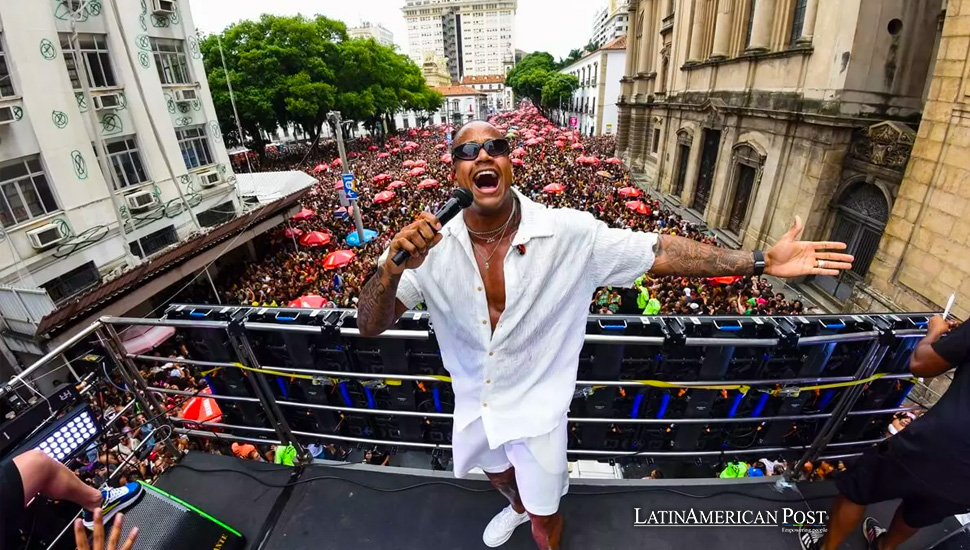Brazil’s Rio de Janeiro Carnival Fever Intensifies with Santana’s Performance

Two weeks before Rio de Janeiro’s famed Carnival, half a million people thronged to Leo Santana’s parade, signaling the city’s mounting excitement for Brazil’s grandest festival.
Rio Carnival’s Prelude: A ‘Gold’ Parade with Leo Santana
In Rio de Janeiro, the anticipation for the annual Carnival reaches a crescendo, as evidenced by the massive turnout for a parade led by Leo Santana, the recent star attraction of Salvador’s Carnival. This weekend, an estimated 500,000 people flooded the streets of central Rio de Janeiro for the ‘Gold’ parade, swaying to Santana’s hits, a stark contrast to the traditional ‘marchinhas’ and sambas that Cariocas are accustomed to.
Santana, known for his unique musical style that deviates from the traditional sounds of Rio’s Carnival, performed atop a ‘trio elétrico’ – a truck fitted with a stage and massive sound amplifiers, a hallmark of Salvador’s Carnival. This distinctive performance offered Rio’s audience a novel way to revel in the festive atmosphere.
Friendly Rivalry and Undeterred Spirits
The friendly rivalry between Rio de Janeiro and Salvador over which city hosts Brazil’s most vibrant Carnival didn’t dampen the spirits of Cariocas. Despite a cold, rainy, and overcast day, they turned out in droves as early as 8:00 AM local time (11:00 GMT), undeterred by the two-hour delay in the parade’s start.
Santana’s parade, his first in Rio’s carnival festivities, particularly resonated with fans of ‘axé’ and other Northeastern rhythms. This region, Brazil’s poorest, is deeply influenced by African culture, and its music has a significant following in Rio. Santana’s performance was a realization of a long-held dream, and he expressed gratitude, especially towards the Northeastern immigrants who attended in large numbers.
The ‘Spanta Nené’ group, one of the 26 ‘blocos’ (parades) that marched on Saturday, paid homage to Northeastern musician Luiz Gonzaga by performing his famous song ‘Asa Branca’ to the samba rhythm. The day also saw other well-known ‘blocos’ like Desliga da Justiça, Imprensa que eu gamo, and Nem muda, nem sai, adding to the pre-Carnival excitement. These parades, led by their bands and followed by thousands in costumes, bring free, festive performances to the streets of Rio.
The Rio de Janeiro City Hall has authorized 453 ‘bloco’ parades for this year’s Carnival, which started last week and will continue until the Sunday following the main carnival event, beginning on February 9. This decision underscores the city’s commitment to preserving and celebrating its rich carnival tradition despite the challenges posed by the pandemic in recent years.
Homage to Luiz Gonzaga and Vibrant ‘Blocos’
The Carnival in Rio de Janeiro is more than just a series of parades and parties; it’s a cultural phenomenon that encapsulates the city’s vibrant spirit, diverse influences, and capacity for joy and resilience. The event serves as a canvas for artistic expression, social commentary, and celebrating Brazil’s diverse cultural heritage.
As the city gears up for the official start of the Carnival, the excitement is palpable, with each parade bringing its unique flavor to the festivities. From Santana’s energizing performance to the traditional samba renditions of ‘Spanta Nené,’ the Carnival is a testament to Rio’s dynamic and inclusive cultural landscape.
Also read: PapJazz Festival: A Melodic Respite Amidst Haiti’s Turmoil
The build-up to Rio’s Carnival, marked by Santana’s parade and other ‘bloco’ performances, highlights the city’s enduring love for its most iconic festival. The event not only showcases the artistic talents and cultural diversity of Rio de Janeiro but also brings together people from all walks of life in a grand celebration of life, music, and community spirit. As the world looks on, Rio de Janeiro once again prepares to host a carnival that embodies the heart and soul of its people.




